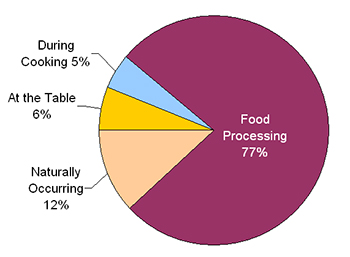
November 2014
Special Edition: Salt Shake Up
(En español)

It was hard to miss the news about salt this past summer. Salt lovers were likely rejoicing when a large international study published in the New England Journal of Medicine questioned long-standing recommendations by suggesting that salt in the diet is OK. Though the overall message may have been more complex, the media seized on the simplified hope of a free pass for salt lovers. However, three recent studies offer concrete evidence that too much salt in the diet elevates blood pressure, which increases the risk of cardiovascular death, stroke and heart attack.
Why should we watch salt intake anyway?
On average, most Americans get about 4,000 milligrams of sodium a day. The evidence on salt is unequivocal and by limiting salt consumption to below 2,000 milligrams daily we can:
- Lower the blood pressure
Especially for those who are older, have pre-existing high blood pressure, and those who consume large amounts of salt. People with normal blood pressure can also benefit from limiting their salt intake.
Consumption of salt in the diet is directly linked with development of high blood pressure. Ninety percent of Americans will develop hypertension before they die. In fact, our blood pressure goes up on average a point per year after the age of 25.
- Reduce the risk of cardiovascular death, heart attack and stroke
An estimated 1.65 million deaths worldwide could be prevented. This includes one of every 10 cardiovascular (CV) deaths worldwide, and one of every five premature (70 years old and younger) CV deaths.

Where salt comes from in our diets.
|
Did you know your food naturally contains salt? We can meet our salt needs by eating meat and seafood, provided we do not sweat excessively. Although many people crave salt, the fact is that sodium is a learned taste. If you can cut it out of your diet for even one week, you may find that you become averse to it altogether.
The American Heart Association recommends getting fewer than 1,500 milligrams of sodium per day, yet the average American still takes in 3,400 to 4,000 milligrams a day. This is way more than we need.
A small amount of salt goes a long way:
1/4 teaspoon salt = 575 mg sodium
1/2 teaspoon salt = 1,150 mg sodium
3/4 teaspoon salt = 1,725 mg sodium
1 teaspoon salt = 2,300 mg sodium
Salt vs. sodium: Are they the same?
Be aware of the sodium content on nutrition labels Processed foods are particularly high in salt. You can find the amount of sodium in packaged food sold in stores by looking at the Nutrition Facts label. The amount of sodium per serving is listed in milligrams, abbreviated “mg.” The sodium content of packaged and prepared foods can vary widely. Compare the sodium content of similar products and choose the one with the lowest amount of sodium you can find.
Here are sodium-related terms you may find on food packages:- Sodium-Free: Less than 5 mg of sodium per serving and contains no sodium chloride.
- Very Low Sodium: 35 mg or less per serving.
- Low-Sodium: 140 mg or less per serving.
- Reduced (or less) sodium: At least 25 percent less sodium per serving than the usual sodium level.
- Light (for sodium-reduced products): If the food is "low calorie" and "low fat" and sodium is reduced by at least 50 percent per serving.
- Light in sodium: If salt is reduced by at least 50 percent per serving
Surprising foods that add sodium to our diets.
Adding spices to your food can be an easy way to skip the salt shaker. Just make sure there's no hidden sodium in your selection.
When IS more salt OK?
The less than 1500 mg/day recommendation does not apply to people who lose large amounts of sodium in sweat—for example, a competitive endurance athlete, or someone like a firefighter who works in extreme heat. In Houston, it is hot and we love our air conditioning but I rarely recommend higher amounts of salt in the diet.
Take the Sodium Quiz.
As you consider salt in your diet remember that adequate intake of potassium will help our bodies stay healthy and balance the levels of sodium. Eating foods with potassium is important in controlling blood pressure because potassium blunts the effects of sodium. The more potassium we eat, the more sodium we excrete from the body through urine. Potassium also has the direct effect of relaxing blood vessel walls, which helps lower blood pressure.
The recommended daily intake of potassium is 4,700 mg for an average adult. Most of us aren’t consuming enough potassium. On average, women consume about 2,400 mg/day and men consume almost 3,200 mg/day.
This doesn’t mean, however, that upping one’s potassium intake is a license to go wild with salt intake.
A great option for an overall heart healthy lifestyle is the
DASH (Dietary Approaches to Stop Hypertension) diet. This diet is rich in fruits, vegetables, fat-free or low-fat (1 percent) milk and milk products, whole-grain foods, fish, poultry, beans, seeds and unsalted nuts. The DASH eating plan helps lower blood pressure. It also has less sodium, sweets, added sugars and sugar-containing beverages, saturated and trans fats, and red meats than the typical American diet.
In older people and those with kidney disease excessive potassium intake can be harmful. So, before taking any over-the-counter potassium supplement, talk to your doctor.
Until next time!

